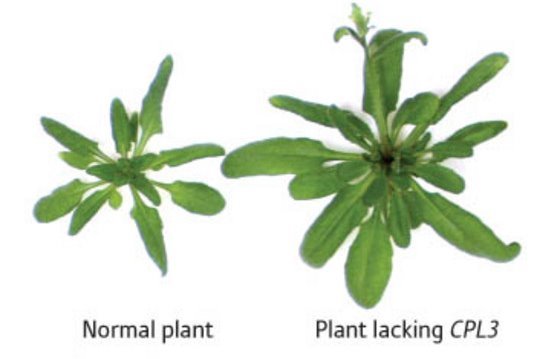Jul. 18, 2008 Research Highlight Biology
Gene family reunion
Japanese plant biologists isolate a gene controlling plant size, flowering and development
 Figure 1: Normal (left) and mutant (right) Arabidopsis thaliana plants. The mutant plants are much larger than normal plants.
Figure 1: Normal (left) and mutant (right) Arabidopsis thaliana plants. The mutant plants are much larger than normal plants.
Differentiation of cells into specific types and patterns is a crucial feature of development in multicellular organisms; and in plants, advantageous changes in cell differentiation can help them to survive under changing environmental conditions.
The plant gene CAPRICE encodes a small protein that promotes differentiation of epidermal cells into root hair cells or hairless cells. Three additional genes that are similar to CAPRICE promote differentiation of these cells. These three homologs are said to act redundantly, because without them, the physiology of the plant does not appear to change.
Now Rumi Tominaga and a team at RIKEN’s Plant Science Center in Yokohama have isolated a fourth CAPRICE-like gene named CPL3 from the popular model plant, Arabidopsis thaliana. CPL3 shares some functions with CAPRICE and the other homologs, but as reported recently in Development 1, the team has discovered that CPL3 boasts several characteristics that make it distinct and crucial to plant development and growth mechanisms.
Cell differentiation was affected in plants with extra copies of CPL3 resulting in overproduction of root hairs, as was observed previously for the other genes in the CAPRICE-like family. The team suggests that CPL3 redundantly regulates epidermal cell differentiation into hairless or root hair cells along with the other CAPRICE homologs. Although CPL3 has diverged partially from the CAPRICE-like gene family by having its own distinct functions, retaining its redundant functions may represent an important evolutionary position for the plant. Because the so-called redundant functions provide the potential for an adaptive response to changes in the environment, they also provide the plant with a strategic plan for survival.
Using mutant plants in which the function of CPL3 was disrupted, the researchers found this gene to have profound influences on flowering time and plant size. Mutant plants lacking CPL3 flowered earlier than normal plants and were much larger (Fig. 1). Endoreduplication is the process of making copies of DNA in specialized cells without undergoing cell division and is thought to provide a mechanism for increasing cell size. The team found that CPL3 controls flowering development, epidermal cell size, and aspects of cell-hair growth through the regulation of endoreduplication. The team will investigate CPL3 in other plants or crops “because a useful plant that grows larger [through] the regulation of endoreduplication might be obtained,” says Tominaga.
References
- 1. Tominaga, R., Iwata, M., Sano, R., Inoue, K., Okada, K. & Wada, T. Arabidopsis CAPRICE-LIKE MYB 3 (CPL3 ) controls endoreduplication and flowering development in addition to trichome and root hair formation. Development 135, 1335–1345 (2008). doi: 10.1242/dev.017947
